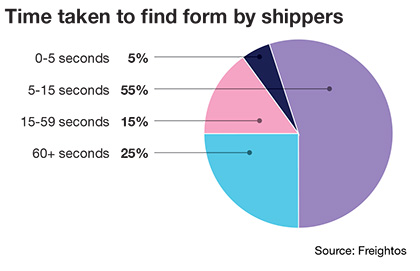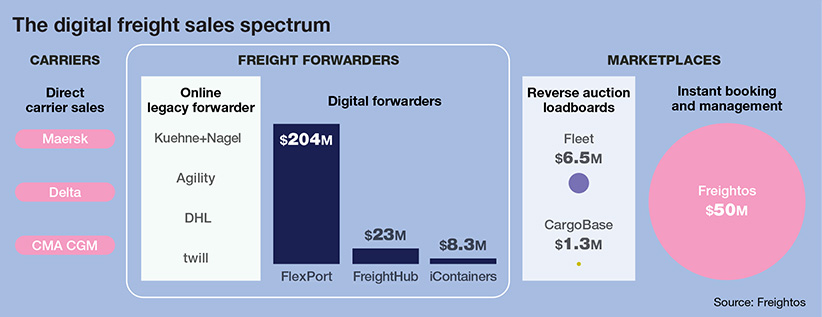Freight Forwarding: Keeping shippers top of mind
In the current rush to digitize for operational efficiency, forwarders must not lose sight of immediate shipper needs. The transition must be smooth, valuable and completely transparent—but is that happening?
Say “freight forwarder” and the first thing that might come to mind would be “forward-thinking,” a market run by visionary leaders who can use predictive analytics to forecast and deliver on new shipper demands.
But just how many of today’s intermediaries are ready to embrace the latest technologies and reinvent global forwarding at lightning speed?
Industry experts surmise that with Amazon storming the gates, and Alibaba not far behind, today’s logistics managers will expect their traditional forwarding partners to adapt quickly—or at the very least—at a steady and measured pace.
Indeed, a recent report by Freightos, a SaaS-enabled logistics technology provider focused on instant freight quotes for freight forwarders and shippers, finds that the world’s top intermediaries are continuing to embrace digitalization. However, it’s their inability to meet shipper expectations that’s holding them back.
Freightos vice president Eytan Buchman maintains that both legacy providers and startups have invested in a great deal of technology over the past 10 years, but some may be barking up the wrong tree.
“What this research suggests is that while the ultimate goal of digitization has traditionally been internal efficiency, the new wave of digitization is driven by customer-facing technology,” says Buchman. “Improved internal processes are, of course, helpful, but today’s competitive landscape is being redrawn by forwarders which are putting shippers’ needs first. Becoming “shipper-centric” will be the next big challenge, because over a third of today’s forwarders don’t even have an easy to use online form.”
Buchman adds that Amazon has shown that a shipper-centric approach is the trick for shipper acquisition and retention, adding that companies like WeWork validated that the same principle holds true in the B2B environment. He contends that a strategy dictated by an improved shipper experience will still drive internal efficiency, however if it doesn’t take into account shippers as the end goal it will likely fail.
“A good example of this is provided by companies that take on piece-meal internal digitization approaches,” says Buchman “While these may help individual departments or countries improve operations, the user experience still remains fragmented.”
Among the report’s key findings was that forwarders that quote manually took 57 hours on average—an improvement on previous surveys, but still 20th century performance. Furthermore, 72% of those forwarders surveyed failed to quote, thereby missing out on digital business.
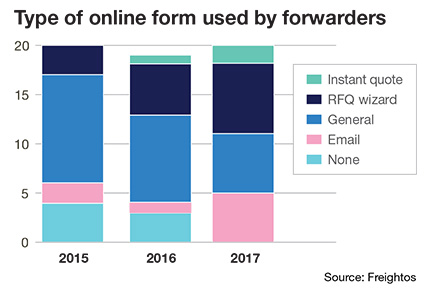 According to Buchman, researchers also discovered that with a significant 58% price spread, pricing transparency is critical, adding that it’s important to note that three of the Top 20 forwarders (DHL Global Forwarding, Kuehne+Nagel, and UPS) now provide instant door-to-door airfreight quotes.
According to Buchman, researchers also discovered that with a significant 58% price spread, pricing transparency is critical, adding that it’s important to note that three of the Top 20 forwarders (DHL Global Forwarding, Kuehne+Nagel, and UPS) now provide instant door-to-door airfreight quotes.
Buchman observes that while political tensions—from new U.S. tariffs to Brexit—are raising new import/export challenges, technology is bridging that at nearly the same pace. “It’s dramatically easier for businesses to source, import, and sell goods around the world,” says Buchman. “And it’s a great time for shippers to enter new markets.”
At the same time, says Buchman, shippers should not be measuring forwarders based solely on their technology, observing that those kind of forays are best left for playing around with the latest iPhone. “Forwarder selection should be a function of reliability, cost, and efficiency,” he adds. “In many cases, those three elements are strongly correlated with provider technology that enables process optimization, reduced labor costs and more shipper-facing efficiencies.”
Moving targets
Freightos analysts say that digitalization makes selling to the lucrative small- and medium-sized enterprise shipper market easier, but shippers are becoming a moving target. New technology options have empowered them with more choices, and B2B customers expect information on demand.
Analysts warns forwarders that failing to digitize their operations may bring on “an extinction event” in the next ten years. “And while some of them may see their irrelevance coming, they may not have enough time to save their forwarding company,” he adds.
Analysts notes in the Freightos report that old guard forwarders face new challenges, other B2B companies are thriving by providing a brilliant digital customer experience. “Freight digitalization winners will be the providers who fully implement a customer-facing strategy through a comprehensive strategic transformation.”
Beth Pride, president of BPE, a trade compliance firm based in San Francisco, says that most forwarders are doing “a decent job” of embracing the latest technology, but they’re hindered when their clients don’t take the time to understand the requirements of shipping globally. “I’ll add that some of the forwarders are at fault, too,” she says. “A few of them only think of the physical and informational movements of a global supply chain. They don’t understand the business side of things.”
As an example, Pride points to a recent episode where a shipper was not told about freight consolidation opportunities for goods moving from the U.S. to Singapore and on to India. “It should have been one seamless move,” she explains, “but the forwarder insisted on having three separate segments. This kind of complication can even happen with transport within North America, as not all forwarders are up to speed on NAFTA documentation. There are a lot of nuances to the global supply chain, and often the freight forwarding community is merely sweeping up after the elephant,” she adds.
Suspicions confirmed
Cathy Morrow Roberson, president of the research firm Logistics Trends and Insights, says that the earlier referenced Freightos report confirms some of her darkest suspicions.
“Digitization is definitely changing how freight intermediaries do business, and it will ultimately determine those who survive and those who don’t,” says Roberson. “At the same time, however, forwarders must not forget the shipper as they invest in digitization. While it may improve how business is done, it’s not the sole answer to customer service.”
Morrow Roberson says that the Freightos survey shows the forwarding market is still in “a trial and error mode” as it moves forward toward achieving digitization goals. “Will they be extinct in 10 years if they don’t fully digitize?” she asks. “Highly doubtful, but they will likely fall behind the competitive pack. The key is for the market to work with shippers to determine pain points, address those pain points, and then take a step or two further with creative suggestions to provide the best customer experience possible.”
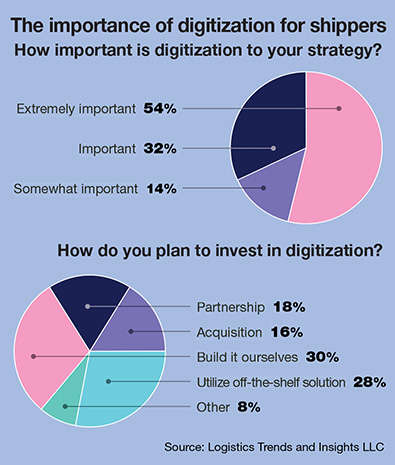 The urgency of strategic digitization is evident in a recent shipper survey conducted by Morrow Roberson that asked 300 of her firm’s premier clients how they plan the implementation of digitized service. “While more than half our respondents said it was ‘extremely important,’ less than a third reported that they plan to invest in digitization. Among that number, we see shippers who are planning to purchase customized digitized solutions or build-it-themselves, and 28% planning to utilize an off-the-shelf solution.”
The urgency of strategic digitization is evident in a recent shipper survey conducted by Morrow Roberson that asked 300 of her firm’s premier clients how they plan the implementation of digitized service. “While more than half our respondents said it was ‘extremely important,’ less than a third reported that they plan to invest in digitization. Among that number, we see shippers who are planning to purchase customized digitized solutions or build-it-themselves, and 28% planning to utilize an off-the-shelf solution.”
A new study conducted by Deloitte and the Manufacturers Alliance for Productivity and Innovation (MAPI) indicates that while U.S. shippers are increasingly aware of the benefits of digitization, many “remain in the early phases” of adoption.
The study, titled “Embracing a Digital Future: How manufacturers can unlock the transformative benefits of digital supply networks,” reveals a disconnect between executives’ opinions of their digitization efforts and actual implementation.
Transportation economist Noël Perry was not surprised by the findings. “Logistics managers are taking a cautious approach to digitization,” he says. “And for the time being, that may be a good idea. They should not be spending too much on new technology at this point, but should be poised to adapt when the time is right, which should come soon.”
Perry, who recently formed the consultancy Transport Futures, also advises managers to stay well informed on dynamic changes in the industry the old fashioned way—by attending conferences and trade events. “The freight forwarding business is still all about personal relationships and building trust,” he adds. “Technology alone can’t do that.”
Start-ups realize tech advantage
Ken Lyon, a board advisor on technology for the London-based consultancy Transport Intelligence (Ti), agrees with Perry’s advice, noting that as the margins in the forwarding business are generally pretty low across the board, levels of investment in technology reflect that reality.
“Established forwarders invested heavily in technology 10 to 15 years ago, and many continue to use those systems,” says Lyon. “Although they are by now embedded into the core of the organization, they are unwieldy, difficult and expensive to maintain.”
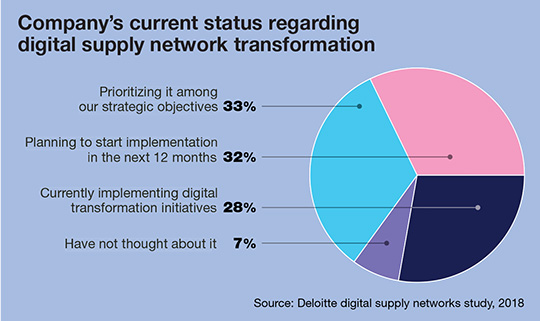 As a result, says Lyon, shippers demanding more information and more agile IT solutions become dissatisfied, and the forwarders are usually forced to introduce external solutions from the Cloud that aren’t integrated with their core systems. “Ironically, the new entrants into the market can take advantage of the newer solutions at much lower cost because they don’t have to worry about integration with older, legacy systems,” he says.
As a result, says Lyon, shippers demanding more information and more agile IT solutions become dissatisfied, and the forwarders are usually forced to introduce external solutions from the Cloud that aren’t integrated with their core systems. “Ironically, the new entrants into the market can take advantage of the newer solutions at much lower cost because they don’t have to worry about integration with older, legacy systems,” he says.
As with all of these things, adds Lyon, any solutions that forwarders introduce must add value for the shipper. He contends that simply introducing a standalone rate selection engine will be pointless unless it’s combined or integrated with an order and shipment management system to seamlessly flow information directly from the logistics manager to the carrier.
Finally, says Lyon, it’s easier for a forwarder to do a wholesale replacement, exploiting a lower cost Cloud service, but that still requires skill and expertise to pull off. “It is also a massively political challenge to sell internally, especially if senior management were the people responsible for the initial investment,” he concludes.

Article Topics
Motor Freight News & Resources
Shipment and expenditure decreases trend down, notes Cass Freight Index March trucking tonnage trends down, reports ATA FTR Shippers Conditions Index enters negative territory DAT March Truckload Volume Index sees modest March gains National diesel average, for week of April 22, is down for the second straight week LM Podcast Series: Assessing the freight transportation and logistics markets with Tom Nightingale, AFS Logistics XPO opens up three new services acquired through auction of Yellow’s properties and assets More Motor FreightLatest in Logistics
Baltimore suing ship that crashed into bridge, closing port, costing jobs Intermodal growth volume remains intact in March, reports IANA Descartes announces acquisition of Dublin, Ireland-based Aerospace Software Developments Amid ongoing unexpected events, supply chains continue to readjust and adapt Shipment and expenditure decreases trend down, notes Cass Freight Index March trucking tonnage trends down, reports ATA FTR Shippers Conditions Index enters negative territory More LogisticsAbout the Author
Subscribe to Logistics Management Magazine

Find out what the world's most innovative companies are doing to improve productivity in their plants and distribution centers.
Start your FREE subscription today.
April 2023 Logistics Management

Latest Resources




